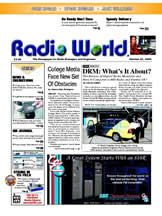
 |
|
|||||||||
|
|
 |
||||||||
 |
Understand Your Dish to Keep Your Audio Online by Mark Persons |
Radio
World Article June 5, 2019 |
|
The sky was black with clouds and street lights were coming on. There was no rain, however; moisture stayed in the cloud cover. A look at one satellite receiver confirmed the signal had gone away. Then the C band (4 GHz) satellite receivers went silent. Satellite programming on all of the radio stations in town was unavailable. The event lasted for about an hour until the clouds dissipated. C band satellite receivers came alive first, followed by Ku band. Today, relatively small consumer television satellite dishes often lose signal when it rains. Fortunately, the broadcast industry uses larger dishes to avoid most annoying outages. |
|||||||
 |
In RW’s Oct. 24, 2018 issue, the article “A Sampler of Common Sense Helpers” featured an anecdote about a problem in which some, but not all, transponders were working on a C Band satellite dish with an LNA (low-noise amplifier). Fig. 1 shows the configuration where two 90 degree N elbow adapters were combined into an innovative and convenient U arrangement. As it turned out, the distance between two sharp right angles resulted in notching two transponders from the received signal. All other transponders were fine. Replacing the adapters with a short flexible cable solved the problem. The wavelength of a 4 GHz C Band signal is only 7.5 cm (2.95 inches) and about 2 cm (0.79 inches) for Ku Band. Significant portions of a wavelength and right angles combined to create the situation. While we don’t see many LNAs anymore, the moral is that unexpected things can occur when handling microwave RF signals. |
||||||
|
Fig. 1: LNA with two 90 degree elbows |
|||||||
WINDA major troublemaker for satellite dishes, as you know, is wind. You’ve seen it where a weather event caused misalignment of a satellite dish. I’ve gone so far as to fabricate steel struts that attach to the sides of dishes with the other ends fastened to the dish pole or even to screwed-in ground anchors. However, those supports need to be detached before any realignment can be done. I made it a practice to mark the locations of adjustments so the dish can be put back to where it started before things went wrong. Those spots are on the fixed pole mount to its rotatable portion. A permanent marker works well for that. I also marked the elevation adjustment and feed horn polarization. It is easy to do and saves lots of time in the future. Then, of course, there are tornadoes and straight-line winds that can demolish a dish. Fig. 2 shows such a dish at a station in northern Minnesota. Even the feed horn was swept away, never to be seen again. This was on level ground — imagine trying to keep a dish aligned on a tall building!
|
|||||||
 |
|||||||
| Fig. 2: A storm-damaged satellite dish | |||||||
|
|||||||
 |
|||||||
|
Fig. 3: The physics of a satellite dish |
|||||||
JUST THE RIGHT CURVEThe physics behind a satellite dish are simple but can be mechanically difficult. Dishes are typically RF reflecting parabolas that must be exactly shaped so a satellite signal will arrive at the LNB from all parts of the dish. Think of a dish as an optical mirror where light focuses on a single point. Radio waves follow the same principles as light, except you can’t see them. A satellite signal heads toward Earth as a wave front. The system works correctly when a wave striking the satellite dish then bounces off to arrive at the focal point (LNB) as a combined signal. The dish shape is a double-edged sword. Signals arriving straight in (on-axis) reflect and add at the focal point, while off-axis signals are reflected to a different point, or are just scattered away from the LNB. As they say, the angle of incidence equals the angle of reflection. A parabolic dish is good at focusing received energy at one point. That is why a dish looks at just one satellite, not others nearby in orbit. A warped dish might reflect signal to the wrong point, causing low dish gain. Ouch! OUT IN FRONTPlacement of the feed horn and LNB is critical, too. Misalignment at the focal point, even by just a few centimeters (fractions of an inch), could mean the difference between a reliable dish and one that is a marginal performer. That usually happens when a dish is warped. You’ve seen this one, too. The satellite signal goes away, and you find a bee or hornet hive in a feed horn. Those critters love a location like that. It is away from animals and somewhat sheltered from rain. Any electrically transparent material can be used to cover the horn. A little plastic sheet, or even plastic food wrap, will do. It’s a maintenance item. Be sure to mark the EbNo, a signal-to-noise performance number, on the front of every satellite receiver. It is easy and quick to check on regular inspections and will tell you when trouble is brewing. Hey entrepreneurs, how about developing a curved broom that will help clear snow and debris from satellite dishes? Knowing the facts helps you be a better engineer. It makes perfect sense. |
|||||||
Mark Persons, ham W0MH, is an SBE Certified Professional Broadcast
Engineer and SBE Engineer of the Year in 2018. He is now retired after
more than 40 years in business. His website is www.mwpersons.com.
|
|||||||
|
This is a reprint of the article which appeared in the online
version of Radio World at:
https://www.radioworld.com/tech-and-gear/understand-dish-keep-audio-online Comment on this or any article. Write to radioworld@nbmedia.com. |
|||||||
|
Questions? Email Mark Persons: teki@mwpersons.com |
|
.